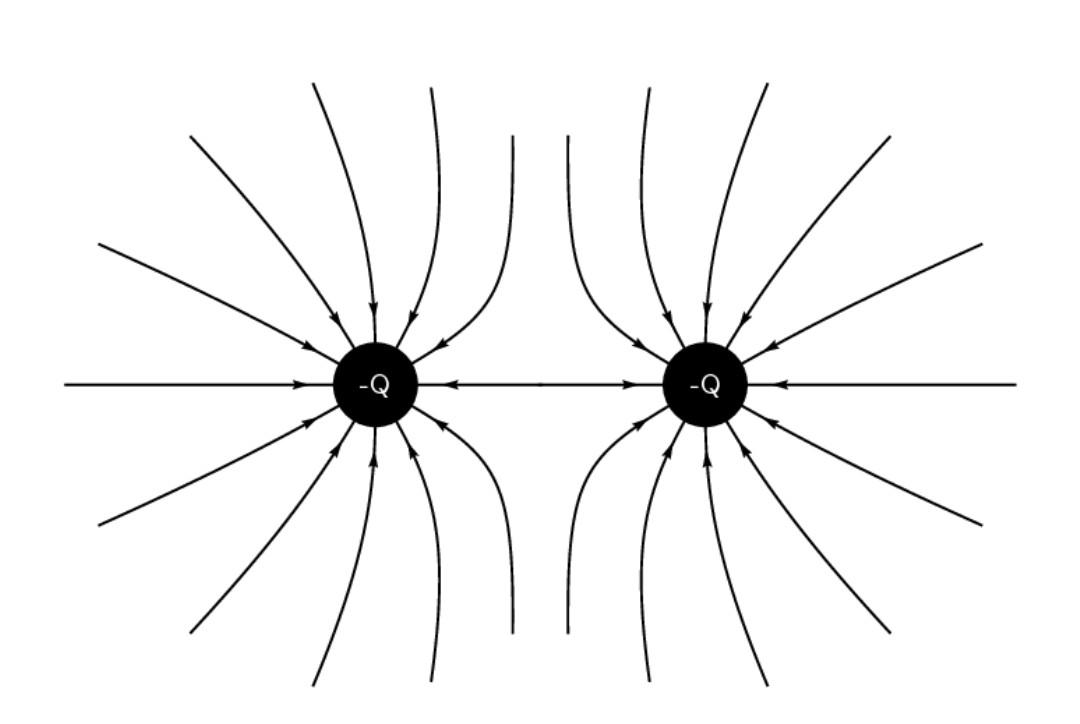Time management is very much important in IIT JAM. The eduncle test series for IIT JAM Mathematical Statistics helped me a lot in this portion. I am very thankful to the test series I bought from eduncle.
Nilanjan Bhowmick AIR 3, CSIR NET (Earth Science)- IIT JAM
- Physics (PH)
Electricity theory
Kindly clear me these basics Q 1) why to the electric field lines between two negative charges is not possible.!!!! Q 2) why electric field can't be negative??? Q 3) what's the difference among test charge ,point charge and unit charge???
- 2 Likes
- 9 Comments
- 0 Shares
-
Himanshu Pandey
Abhishek sir regarding first question can we not draw field lines like in this fig, ?????in very few cases i found this diagram but most places it is said impossible to draw.
![cropped6467654243764132600.jpg]()
![eduncle-logo-app]()
it's impossible to draw like that. the straight line joined is sure a typo or the Author had done a big mistake!
-
![comment-profile-img]() >
>
Abhishek singh
3) A test charge is a positive charge of very small magnitude which gives the direction and strength of electric field in space without influencing the electric field, whereas a point charge has a finite charge only but no observable mass or size.It is a hypothetical assumption to neglect the gravitational force, while the unit charge is a charge with unit magnitude (not 1 Coulomb though, as 1 Coulomb is a huge amount of charge) , it could be 1 micro Coulomb or 1 nano Coulomb.
-
![comment-profile-img]() >
>
Abhishek singh Best Answer
2) Your second question should be a general one! what I mean by that? I mean this question is valid for all vector (not just electric field vector). Vectors are never positive or negative! you can only talk about scalar for positive or negative. I have never heard of positive (or negative) force or positive (or negative) electric field. In case of force, work done could be negative or positive (as it is a scalar). In case of electric fields, the potential could be negative or positive! So using positive (or negative) for vectors is not correct in Physics. if any book has done this, they definately would not have meant this.
![eduncle-logo-app]()
any discussion would be appreciated!
-
![comment-profile-img]() >
>
Abhishek singh
![best-answer]()
your first question is interesting one. it took me almost a minute to think of it (that how could I make you to understand this). Now I am sharing my thoughts with you. let say you have two negative charges, one at x=0 and other at x=2 (you may take any unit of length, let say 2 metre). Now let us assume their are electric field lines between the two charges joining them. Now tell me, what direction you would give to it. from left to right(i.e. from the charge at x=0 to x=2) or right to left? you cannot given any direction! (why?) because both the charges are negative both should have electric field lines moving away from them(but you cannot assign two different directions in a single field line). Think on it! you will definitely get your answer. Regards.
![eduncle-logo-app]()
you may still ask doubts.
![eduncle-logo-app]()
i comment query in box.
![eduncle-logo-app]()
commented
![eduncle-logo-app]()
I replied to you comment. is it clear to you now?
![eduncle-logo-app]()
your*
-
![comment-profile-img]() >
>
Dhairya sharma
dear I hv already attached see that.
-
![comment-profile-img]() >
>
Dhairya sharma
answer 2.... An electric field is neither positive or negative. It is defined as being the force acting per unit positive charge . (This means it is a vector like force is). The definition shows us that as positive charges repel, the field must be directed away from a positive charge and towards a negative charge If you move a positive charge in the direction of an elkectric field, work is done by the charge. If you move it the opposite way work has to be done on the charge. To represent these two situations, it is not the field that is negative but the displacement vector. A movement in the direction of the field is a positive displacement whereas in the opposite direction to the field we say the displacement is negative.
![eduncle-logo-app]()
Test charge and point charge are synonymous in the sense that both are unit positive charges. ... a point charge is the one with dimensions so much smaller than the other dimensions appearing in the problem so that they can be ignored; while a test charge is the one which is used to test the effect of an electric field..
-
![comment-profile-img]() >
>
Chandra prakash
![best-answer]()
answer 3.. Point charge: Any charge whether positive or negative, whose electric field is to be found at a particular distance(point) is called point charge. Test charge: Any charge whose magnitude is very small, in fact negligible, as compared to that of the point charge, and which does not affect the electric field of the point charge, whose magnitude is to be found out, is called test charge.
![eduncle-logo-app]()
Test charge and point charge are synonymous in the sense that both are unit positive charges. ... a point charge is the one with dimensions so much smaller than the other dimensions appearing in the problem so that they can be ignored; while a test charge is the one which is used to test the effect of an electric field..
-
![comment-profile-img]() >
>
Chandra prakash
answer 2.... An electric field is neither positive or negative. It is defined as being the force acting per unit positive charge . (This means it is a vector like force is). The definition shows us that as positive charges repel, the field must be directed away from a positive charge and towards a negative charge If you move a positive charge in the direction of an elkectric field, work is done by the charge. If you move it the opposite way work has to be done on the charge. To represent these two situations, it is not the field that is negative but the displacement vector. A movement in the direction of the field is a positive displacement whereas in the opposite direction to the field we say the displacement is negative.
Do You Want Better RANK in Your Exam?
Start Your Preparations with Eduncle’s FREE Study Material
- Updated Syllabus, Paper Pattern & Full Exam Details
- Sample Theory of Most Important Topic
- Model Test Paper with Detailed Solutions
- Last 5 Years Question Papers & Answers
Sign Up to Download FREE Study Material Worth Rs. 500/-












 >
>

 >
>
 >
>







Himanshu Pandey
AS your answer and logic i completely understand
That's great! Stick to that idea only. Abandon the book where you find such mistakes!